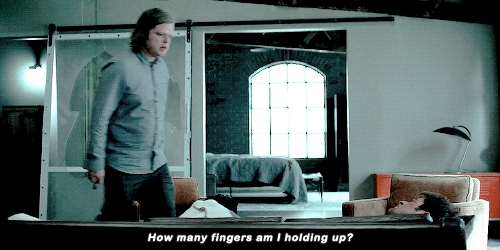
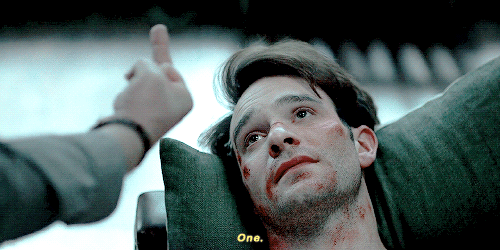
In my lifetime, we’ve seen two major movements in how comic stories are told, and both occurred in Daredevil.
First, there was the movement away from the emphasis on words and thought bubbles, with panels representing still-images in time–illustrated stories. Frank Miller and Klaus Janson brought fluidity between panels (and a maturity in storyline) that made comic books something more than picture books. They were now like movies. And they were violent. Relatively realistically violent.
Then, Brian Michael Bendis and Alex Maleev advanced the neorealism movement by basically telling one long story: A life. Their work on Daredevil was a biography, not a series of 4- or 6-issue stories chained together by theme or a few ongoing relationships. The character changed slowly, gradually, until he hit bottom. Their Daredevil wasn’t about events, it was about the person.
That’s why I’d argue that Daredevil is the Marvel comic that matters most in the history of the medium.
Here’s my favorite DD tales . . .
THE TOP 40 DAREDEVIL STORIES
40. The Death of Jeanne DeWolff (Peter Parker the Spectacular Spider-Man #107-110) (1985-1986)

Obviously, this is one of the best and most famous stories of the’80s. I’m not putting it higher on this list of Daredevil stories because it’s really a Spidey tale. But DD plays an important role–and shares his secret identity with Spider-Man.
So, it’s a nice way to kick this all off.
39. Alone Against Absorbing Man (Daredevil #360) (1997)

The title says it all. A fan-favorite issue from the underrated and under-remember Karl Kesel run.
38. Badlands (Daredevil #219) (1985)
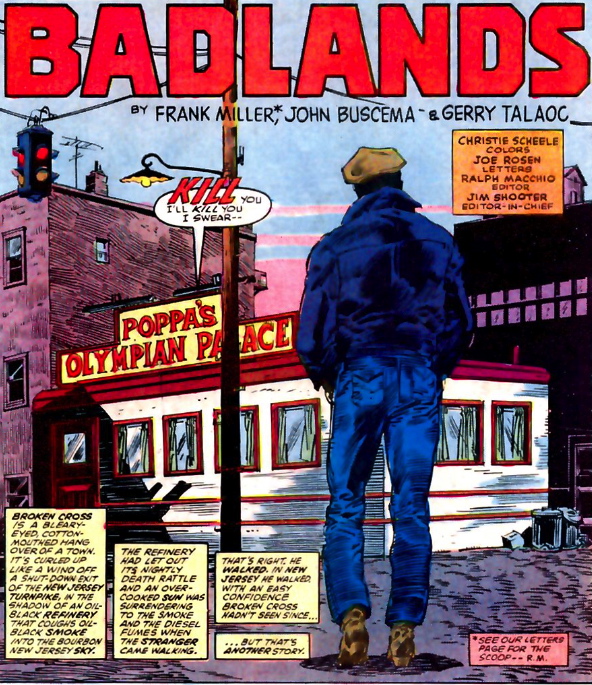
Frank Miller returns after several years of absence and writes a Daredevil story where he never wears his costume and it’s not even clear that he’s Daredevil. And it’s a Western.
Genius.
37. The Face You Deserve (Daredevil #239-240) (1987)

From Ann Nocenti’s misunderstood run, with art by Louis Williams, Daredevil takes on a modern-day Jack the Ripper.
It’s dark. But it also introduces a gang of kids who will hang out with DD for a while, and he rides a skateboard to impress them.
36. Stilt-Man (Daredevil #8)(1965)
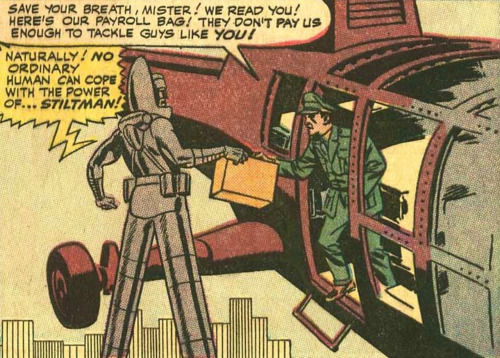
It might be sad that I consider Stilt-Man to be the definitive Daredevil villain. Not Elektra. Not Kingpin. Not Bullseye. Not Typhoid Mary.
Stilt-Man rules.
35. Pawns of the Purple Man (Marvel Team-Up Annual #4) (2008)

Every comic nerd has to have his quirky pick, and this one is mine. Written by Miller (who also did the cover), and drawn by Herb Trimpe, this is just a fun superhero story with a truckload of my favorite heroes (including, of course, Spider-Man and DD, along with Power Man, Iron Fist, and Moon Knight). This wasn’t reprinted in the “definitive” three-volume “Daredevil by Frank Miller and Klaus Janson” series. Too bad.
34. Daredevil in the snow (Daredevil #7) (2011)

Daredevil leads a group of kids to safety during a snow storm that messes with his radar sense. A lovely little done-in-one by Mark Waid, with extraordinary art by Paolo Rivera.
33. Daredevil: The Man Without Fear (1993)

Miller + Romita Jr. retelling, and adding much detail to, Daredevil’s origin. Widely recognized as the definitive version of this story.
32. Lady Bullseye (Daredevil #111-115) (2008)

Ed Brubaker and Marko Djurdjevic created a female version of Bullseye who tried to take over The Hand, and her secret identity is a lawyer who fights Matt Murdock in court.
31. What If? Elektra Had Lived (What If? #35) (1982)
Frank Miller takes his art from original Daredevil issues and then adds new dialogue to show what would have happened if Bullseye had never killed her.
It’s the first time Frank Miller writes a happy ending–as she and Matt Murdock end up together. And of course, it’s not canon.
30. The Jester! (Daredevil #42-46) (1968)

The first appearance of The Jester, Daredevil’s version of Joker, in a story by Stan Lee and Gene Colan. I feel like Colan’s work should be recognized on this list—because it was great—and this story also has DD fighting Captain America. So that’s cool.
29. Blind Alley (Daredevil #163-164) (1980)

The one where Daredevil uses his brains to defeat The Hulk, and winds up in the hospital. Frank Miller was the artist, and it’s cool to see him draw something you don’t normally think of when it comes to Frank Noir: One long, extended superhero battle in the daylight. And Roger McKenzie, a fairly traditional author, did a good job with the Banner/Hulk sequences.
28. Redemption (Daredevil #196-200).

The issues leading up to #200, show Daredevil going to Japan to try to figure out where Bullseye is being holed up and healed up. The conclusion, #200, sported a fantastic John Byrne/Terry Austin cover, and a script by Marvel editor Denny O’Neil. DD and Bullseye meet in the same ring that Battlin’ Jack fought in when Matt was a kid and, with a broken hand, Daredevil beats the living crap out of his greatest adversary. The William Johnson period isn’t a great one artistically, but this story has merit as a chapter in the Bullseye/DD legend, and also for its use of Matt’s personal history.
27. Guardian Devil (1998)

Kevin Smith and Joe Quesada’s 8-issue miniseries about Catholicism. Daredevil ends up caring for an infant who might be the antichrist.
26. Ikari (Daredevil #23-27) (2013)

Mark Waid and Chris Smanee introduce a mysterioius villain, Ikari, who makes calculated attacks on Daredevil. He’s a new character, though, so why does this all feel so personal?
It’s all revealed when we learn Ikari is really…I won’t say. Go read it.
25. Lowlife (Daredevil #41-45) (2003)

The big bad here is The Owl selling mutant growth hormone, and we get to see Bendis take on Luke Cage for the first time. But the best part is the introduction of Milla Donavan. She’s smart, sexy, blind, and Matt’s future wife. A great little story that relates heavily to the surrounding arcs, but still can be read on its own.
24. In Mortal Combat With…Sub-Mariner (Daredevil #7) (1965).
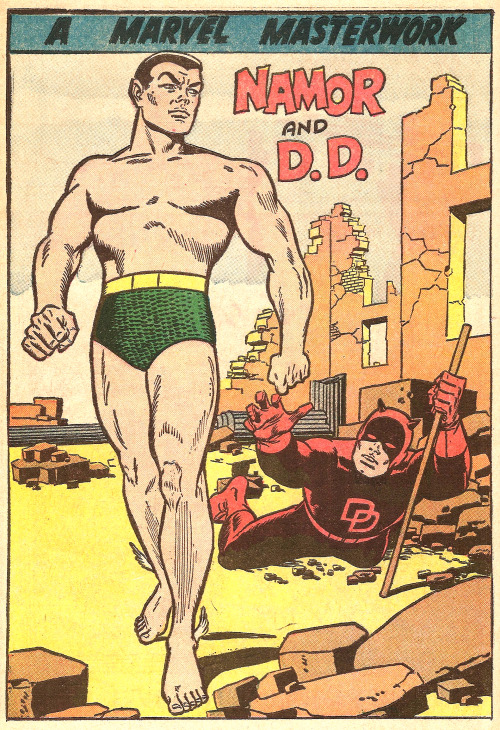
Just as Colan needed representation, so did Wally Wood. This story by Stan Lee has Daredevil fighting Sub Mariner. Yes, Namor. A super-powerful dude. But really, it’s about Matt Murdock’s lawyering skills as he takes a case of Namor suing humans for their damages to Atlantis. Classic.
And check out that Wally Wood pin-up….
23. Parts of a Hole (Daredevil Vol.2 #9-15) (2003)

Written by David Mack with artwork by Joe Quesada, David Ross, Rob Haynes and Jimmy Palmiotti, this story introduced Maya Lopez, a deaf woman who Matt falls for, giving his life some new meaning in the wake of Karen Page’s murder. However, what he doesn’t know is that Maya Lopez has been manipulated by the Kingpin into believing that Daredevil murdered her father. Decked out as the vigilante Echo (she has a big white handprint on her face, to echo the bloody handprint her father left as he died), she has photographic reflexes, similar to the villain Taskmaster. So she can echo anyone’s skills that she studies. She is also a highly trained athlete, so that allows her to implement the skills she studies. So when she takes on Daredevil, it is tough for Matt, as he instantly recognizes her (she isn’t exactly wearing much of a disguise), so how does he handle fighting the woman who he has fallen for?
22. The Murdock Papers (Daredevil #76-81)(2005)
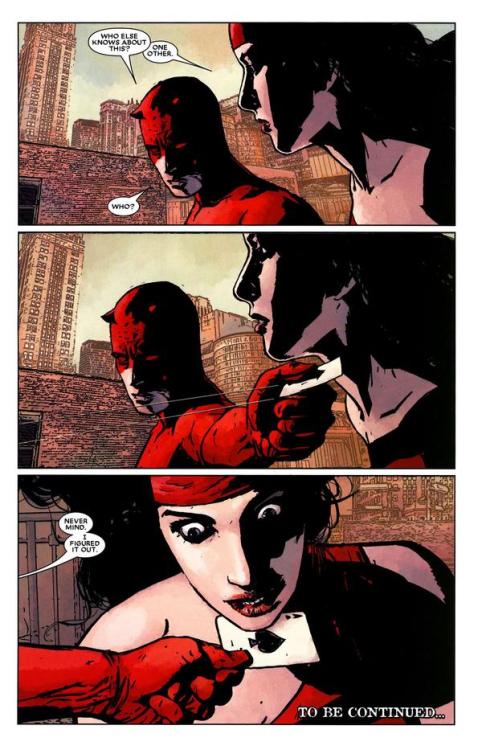
The conclusion to the second-most heralded Daredevil run of all time, Brian Michael Bendis and Alex Maleev, exemplifies everything that made the run great. Kingpin seeks immunity from prosecution by offering up Daredevil’s secret identity to the FBI. There are shades of “Gotham Central” here, as we see how the lives of law enforcement are made more complicated by the presence of a costumed vigilante who is far more competent than they could ever be. Plus, we get to see a threesome between Matt, Elektra, and Black Widow. Okay, not really. But there is clear sexual tension.
21. Return of the King (Daredevil #116-500) (2009)

The final arc in the Ed Brubaker/David Aja run, a worthy successor to Brian Michael Bendis, brings back Kingpin and sets up Daredevil as as the leader of The Hand. The reason this is one of the greatest stories ever is the introduction of Master Izo, an immortal ninja who was Stick’s sensei—making him sort of like DD’s grandpaw. Izo’s character is hilarious and scary, and this tale recalls Brubaker/Aja’s amazing work on the Iron Fist title.
20. Guts (Daredevil #185) (1983)
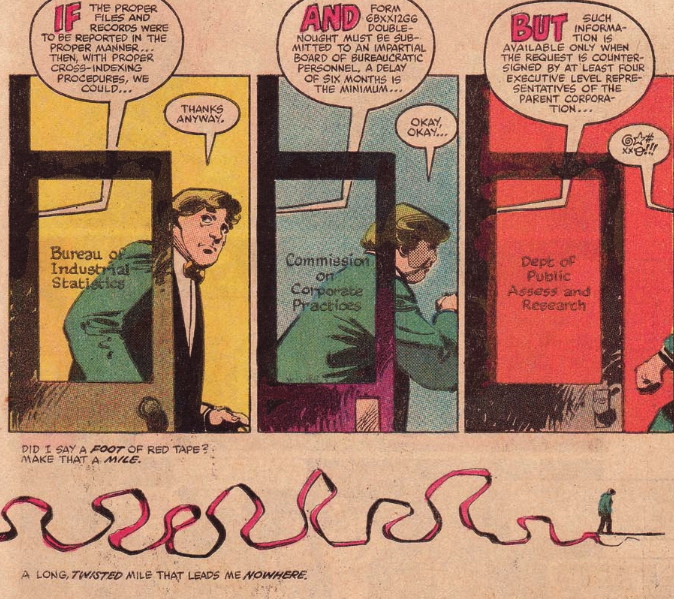
There are so many great Frank Miller stories about Daredevil. And when you’re looking for a one-off, do you go with Stilt-Man? It was fun. The classic “Roulette” story in #191? Maybe. But I go for this issue, wherein Foggy Nelson takes over as narrator; Turk tries to become a powerbroker; Foggy faces down Wilson Fisk; and all the while Daredevil works in the background to protect Foggy from his own hubris. This issue is tailor-made for a TV adaptation, and I kept hoping I’d see it on the Netflix show.
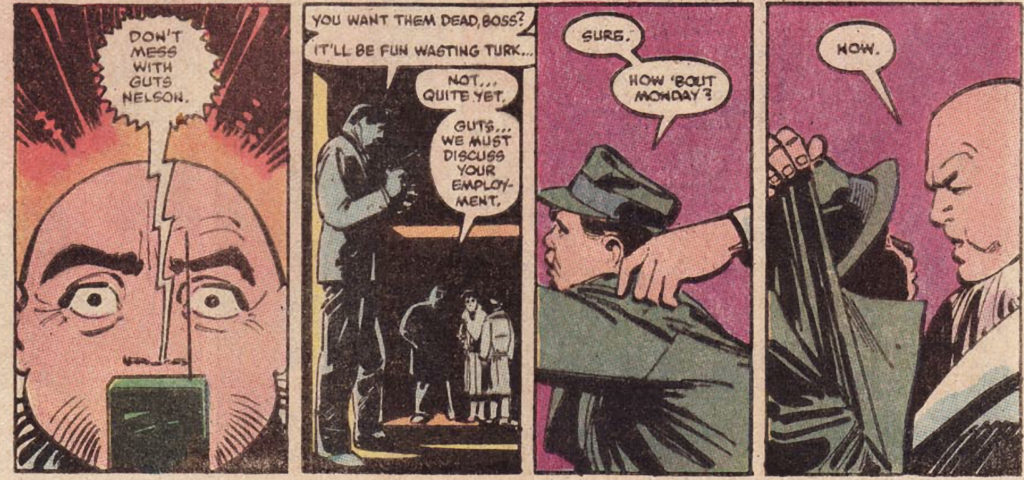
It’s a done-in-one comedy break, but at the same time it advances the storyline and shows that when it comes to women, Matt Murdock is kind of an asshole.
19. Daredevil: End of Days (2012-2013)

A much-maligned miniseries by Brian Michael Bendis and David Mack, with art by Mack, Klaus Janson and Bill Sienkiewicz. People hated this book, and I don’t understand why. It’s a future murder mystery investigating who killed Daredevil. (So DD himself isn’t really in it). And according to Bendis, it is in fact canonical.
Yeah, it borrows heavily from Citizen Kane—but who cares?
Plus, the depiction of Punisher in this comic was terrific.
18. Daredevil #1 (1964)

The first time we met a blind hero. A heroic origin story. An interesting cast. An all around terrific #1 issue.

17. Underboss (Marvel Knights: Daredevil #26-30) (2002).
Brian Michael Bendis and Alex Maleev introduce the Machiavellian Mr. Silke, who engineers an assassination of Kingpin by his own family. But of course he’s not really dead. Maleev adds texture, atmosphere, and reality by using photorealistic backgrounds and pervasive, heavy darkness. And Bendis’ writing has never been better.
All of the major themes of the team’s multi-year run are introduced: identity and privacy; the power vacuum left by the departure of Wilson Fisk; and the time-hopping story-telling style. You can’t casually read this. You have to pay attention.
16. Daredevil: Love and War (Marvel Graphic Novel #24) (1986)
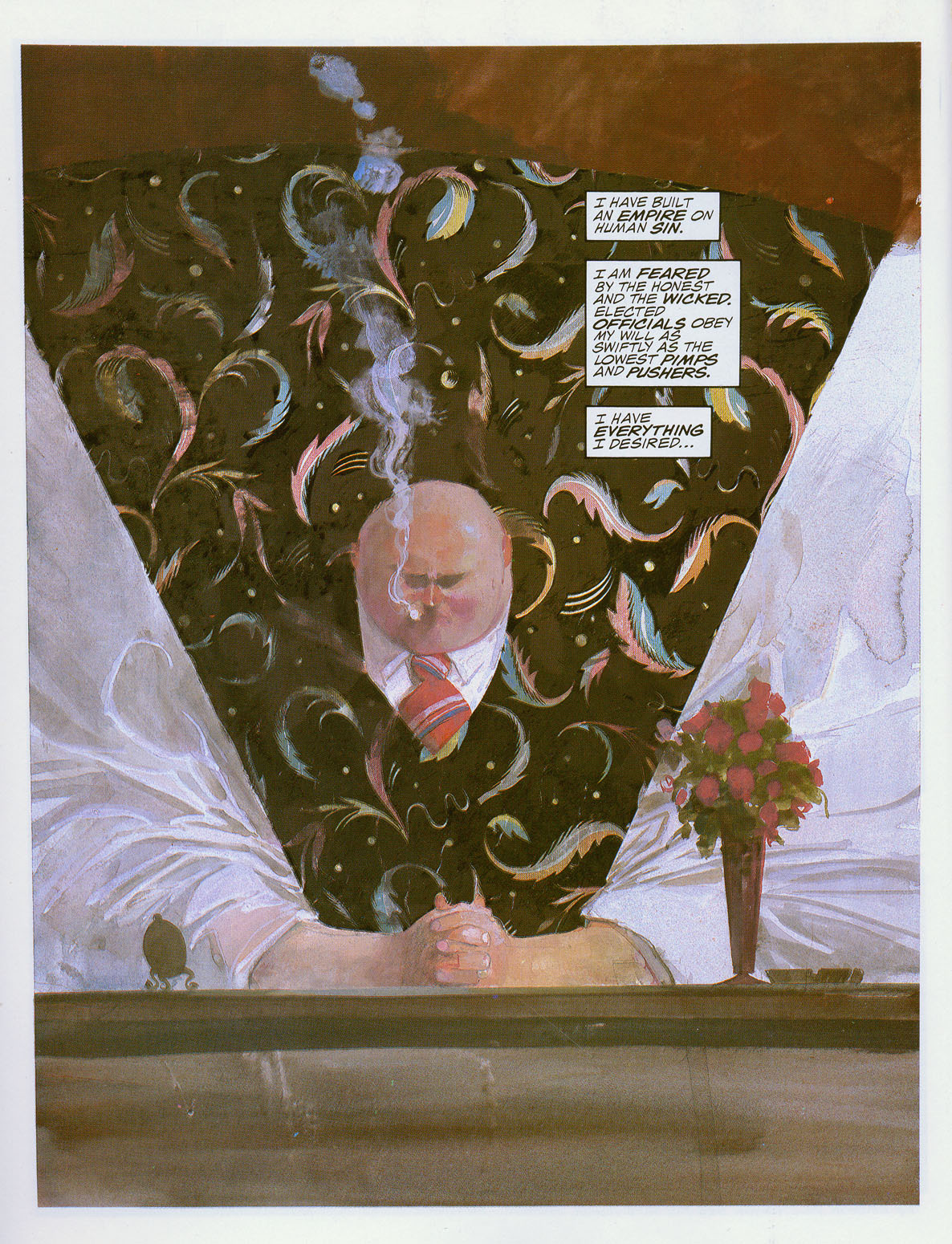
A graphic novel that’s mostly about Kingpin trying to revive his comatose wife. So it’s really a love story. The art is tremendous.
Written by Frank Miller and beautifully illustrated by Bill Sienkiewicz, it is reprinted in “Daredevil By Frank Miller & Klaus Janson Vol. 3,” and the entire book is worth buying just for this story. (The rest of it is awesome, too, of course.) Miller’s writing has never been so taut and emotional, and Siekiewicz manages to make water-colors chilling. It tells the story of how and why Vanessa Fisk left the country for Europe, and marks a high point in both of the creators’ careers. An important chapter in the life of Daredevil’s mortal enemy, but also in the work of two of the best comic-book creators of the 1980s. It’s also the rare example of humanizing Kingpin…

Knowing their backstory, it’s fascinating to see Kingpin being so tender with a woman who has consistently betrayed him (see, for example, #17).
15. Daredevil Gets a Suit (Daredevil #14) (2015)

Mark Waid and Chris Samnee’s DD #14 may seem like an odd one to put on my list, as it is in the middle of a very strange arc involving The Owl and The Shroud, but it exemplifies the joy of this run. Daredevil is so happy being Matt Murdock (and vice-versa), that he even appears in court in a dashing red suit! We’ve never seen DD this happy. No. We’ve never seen ANY superhero this happy. This is the guy we all wanted to be when we were seven and tied a towel around our neck, prending to be superheroes. A perfect comic book.
14. “The Typhoid Mary Saga” (Daredevil #254-257, 259-263) (1988)

In this story, Murdock meets a schizophrenic, pyrokinetic mutant who knows karate and has been hired by Kingpin to kill Daredevil. She’s like Elektra in many ways (yes, they fall in love), but so much more full of crazy. There’s a reason why she’s a fan-favorite villain, and this is it.
13. Bullseye hijacks a TV studio (Daredevil #146) (1977)

An early Bullseye appearance where he takes over a TV studio and shoots Daredevil.
12. Daredevil vs. Doctor Doom (Fantastic Four #39-40 & Daredevil #37-38).

tan Lee, Jack Kirby, and Gene Colan tell the tale of Dredevil switching bodies with Victor Von Doom in a bizarre turn of events that also features Spidey, Thor, and The Trapster. Lots and lots of fun.
11. The Deadliest Night of My Life!/Blast From the Past (Daredevil #208 and 209). (1984)

There are a few comics I’ve read more than 20 times. Spider-Man vs. Juggernaut. Uncanny X-Men #143. And Daredevil #208. The tale, written by Harlan Ellison and Arthur Byron Cover with pencils by David Mazzucchelli, concerns a booby-trapped house and a creepy, suicidal “girl” robot. It’s got some of the best non-combat action sequences I’ve ever seen, and it’s just a rollercoaster ride that never lets up. Arguably, this is really just a great adventure book, not a great Daredevil book, but remember: Before Frank Miller, Daredevil was more of a swashbuckler than a street soldier. This story was more in the former tradition. To my knowledge, it, like the rest of Mazzucchelli’s great run on DD, has never been reprinted in color. For shame, Marvel, for shame.
I doubt there are many people other than me who remember this issue, let alone who would place it on a top 10 list. So if you disagree, tell me why. Or get your own blog!
10. “Child’s Play” (Daredevil #183-184) (1982)

The two iconic covers–#183 (Punisher shooting Daredevil in the belly) and #184 (DD aiming pistol at the reader with “No More Mister Nice Guy” in huge capital letters)—announced immediately that this was not going to be your every day Daredevil story. Even by the high Miller/Janson standards, this is pure gold. The story—about kids using PCP—could easily have come off as a morality play, like an afterschool special, but it was handled without condescension. Punisher was a perfect foil for Matt Murdock, particularly in retrospect–knowing where Miller (then Bendis, then Brubaker, then Diggle) would take the character later–and their rooftop dialog on whether justice requires death or prison, is startlingly prescient.
Note: I’m not the only one to respect these covers–#183 was picked as the second-best DD cover of all time here.
9. Out (Daredevil #32-40) (2002-2003)

It’s tradition: Every Daredevil creative team has to bring the character to rock bottom. That’s what happens here. Silke, who tried to take down Kingpin in Brian Michael Bendis and Alex Maleev’s brilliant first arc, turns state’s witness and gives the FBI Daredevil’s secret identity.
They say nothing changes in the corporate comic book world, and it’s generally true. Like when Spider-Man revealed his secret identity to the world, Marvel erased that past from everyone’s memory. But when Bendis and Maleev exposed Matt Murdock as Daredevil, it stuck.
For a time at least.
8. The Return of Elektra (Daredevil #187-191) (1983)

Yes. Frank Miller is all over the top 10. The above issues focus on Elektra’s resurrection–which we all saw coming, given that Stick’s team had already shows their ability to revive corposes. But the clincher here is issue #191. Daredevil Russian Roulette with a hospitalized Bullseye, who is unable to move. The perfect capstone for Frank Miller’s first run on Daredevil.
7. The Devil in Cell Block D (Daredevil #82-87) (2006).

This was Ed Brubaker and Michael Lark’s first DD story (they’d previously worked together on the Noir-ish, amazing, Gotham Central series for DC), and Bendis had really left them in a pickle, with Matt’s secret identity revealed, and the character in prison. The team showed how Matt navigates the dark world, where he’s locked in with all of his enemies.
6. A Beer with the Devil (Daredevil #266) (1989)


The one where he has a beer with Mephisto. Brilliant. Everything Ann Nocenti ever wrote is basically summed up in this book–she had a very offbeat, fascinating perspective.
Her run is not without controversy. Many found her to be an acquired taste (and many of those never acquired it). But there were several issues–not just the creation of Typhoid Mary–that were remarkable during her run.
Like I flirted with including issue #276, where Daredevil fights alone against Ultron, because it was just so awesome (and the rare example of an event tie-in that actually worked).
But I went with this story instead. It’s a simple coversation–Matt Murdock having a drink in a bar with a mystery lady on Christmas Eve. It’s also a good pallette cleanser between extremely heavy and emotional issues in Nocenti’s run.
5. Daredevil: Yellow (2001).

Back before Jeph Loeb became a Buckheimer hack, he used to be able to write characters. Daredevil: Yellow was part of Loeb’s terrific “color” series, in which Loeb reexamined the motivations for Marvel’s main characters (if you haven’t read Hulk: Grey, do it now). He retold their origins, but from a modern perspective. Here, Daredevil struggles to come to terms with the death of Karen Page. In so doing, Loeb shows how Daredevil went from his generic Silver Age persona to a darker character, more willing to tread the edges of justice. And Tim Sale is always fantastic. There are few artists whose work alone will make me buy a book, regardless of the content or author, but Sale is one of them.
4. The Purple Children (Daredevil #8-10) (2014)

Mark Waid and Chris Samnee explore the legacy of Purple Man’s having raped dozens of women: He’s got dozens of children. And they all have his abilities. And they’re pissed.
3. Hardcore (Marvel Knights: Daredevil #46-50) (2005)
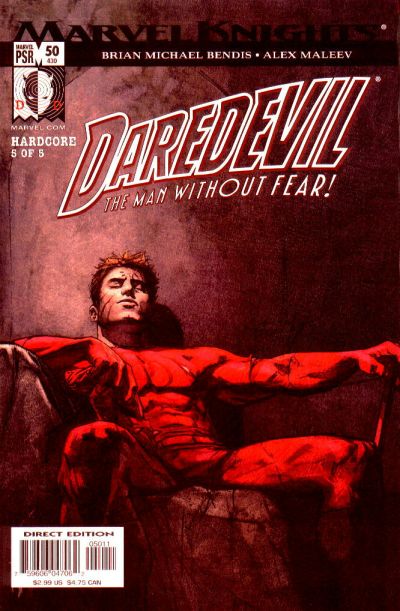
Brian Michael Bendis’ Daredevil run is almost as legendary as Frank Miller’s. This arc, drawn by Alex Maleev, has Kingpin engineering hits against Daredevil by Bullseye and Typhoid Mary. Yes, we’ve seen Kingpin use these characters before. But rarely are the stories written this well. And the ending is the clincher:
Daredevil unseats Kingping and becomes the new crimeboss of Hell’s Kitchen!
Plus, it’s got Punisher.
Note: This is sold in trade as The Devil Inside and Out Volume 1.
2. The Story of Elektra (Daredevil #168-172, 174-177, 179-182) (1980-1982).

Yeah, I”m grouping these together. Maybe that’s a cheat. But I don’t think so. (And if I didn’t group them, there’d barely be space for anything other than these issues on the list.). The beats are gradual: #168 introduces Elektra.
#169 focuses on Bullseye, who is hallucinating and seeing Daredevil everywhere. Issues #170-172 develop Kingpin and tell us, for the first time, that his real name is Wilson Fist. We then meet The Hand, and Stick, for the first time. And then comes the war between all the parties. Bullseye kills Elektra, Daredevil cripples Bullseye. With all that, it’s easy to forget that Elektra “killed” Ben Urich during this story as well. And that Bullseye figured out that Matt was Daredevil. And that Bullseye ambiguously “fell” when Matt “lost his grip.”
So much here. A brilliant set of issues.
1. Born Again (Daredevil #227-233) (1986).

Frank Miller returns to the character after a several-year hiatus, with David Mazzuchelli on art chores, to tell the story of how Kingpin completely levels Matt Murdock. The character work is tremendous—the best examination of Wilson Fisk since Love and War (see above). And Miller does it without being dialog-heavy, like Bendis. This arc accents the difference between the two writers’ styles. Born Again is the perfect end to Miller’s run. It is the best Daredevil story of all time. And not just according to me. Everyone agrees.


These are all fantastic choices, but you have totally neglected, ( perhaps on purpose, for some reason?? ) the very excellent Gerry Conway era featuring DD’s legendary relationship with the Black Widow. Unless I’m mistaken, this relationship was the very first time we saw a relationship in comic-books that was apparently heavily-consummated outside of marriage. We know what DD and the Widow were up to in Natasha’s leased San Francisco mansion! It was just ground-breaking for funnybooks! Gerry Conway brings a maturity to everything he writes, which transcends the medium. The “Mister Kline” storyline from around this same period, also deserves acknowledgement. I think the Death-Stalker is one of DD’s greatest all-time villains, and he deserves acknowledgement, as well. As a matter of fact, the combination of Death-Stalker, the Gladiator, the Man-Thing, ( big favorite of mine ) and the Florida Everglades ( is there truly a more dismal place to die-??? Ditto for the Louisiana Everglades ) all combine to make DD/Widow#113-114 two of my favorite all-time DD issues. Issue#158’s final showdown with the diabolical Death-Stalker ( first Miller issue! ) also deserves a place on this list! I will agree with you on issues#45-46 for the same reasons you listed- that moody Gene Colan artwork! Gene the Dean! Ah, yes!! Issues#37-38 ( DD vs. DD!! ) issue#7, Sub-Mariner sues the Human Race-awesome! Beats DD into paste!! Of course! How could he not?? And FF’s #39-40 ( “And A Blind Man Shall Lead Them!”/”The Battle for the Baxter Building” showing DD in top form against an adversary who he has totally no chance of defeating- his hopeless battle against the Hulk, from issue#163, for the same reason. So- there’s my two cents on the best of Daredevil!
The Gerry issues were just not that good. Great concept, but poorly executed (mostly). Colan’s art was great. The Namor issue was fantastic–but not as good as the ones I picked (imho).
Excellent choices friend, your nominations between phases and individual issues turned out pretty cool (although I don’t share the Elektra saga the same way) Daredevil is largely consistent and well written, it’s nice to name your best stories, but I still find it hard to rank them.
I particularly enjoyed the various nominations for Daredevil’s Silver Age, Stan Lee’s run is as iconic as Gene Colan’s (honorable mention to Wally Wood), but I’d like to nominate other stories I missed.
Redemption by David Hine; Last Rits by Chichester; Over the Edge (343-350) by DeMatteis, The Trial of Mr. Hyde by Karl Kesel (354-357), Daredevil and Punisher: Mean and Ends and Part of Devil (95-99) by Brubaker
As for individual Issues, I think 4, 6, 18/19 131/132 (first appearances of Killgrave, Mr. Fear, Gladiator and Bullseye), 94 by Brubaker (They Can’t See Their Love Blind), 223 ( The Price) and 220 (Fog) by Dennis O’neil and 47 (Brother, take my hand), are just a few that come to mind.
Some others, silly this time, are the initials of Mike Murdock and the first participations of the Black Widow (before San Francisco), the last one not so silly is the… one-shot/miniseries (?), anyway, Jack Batlin Murdock, which I like a lot.
By the way, what do you think of the Zdarsky Phase? I ended up enjoying the opening part of Run and its first climax, but I don’t know what to expect from Devil’s Reign (I’m considerably behind), otherwise, great list.
Thanks! I haven’t read the Zdarsky stuff yet, but will get there eventually.
Love your individual picks!